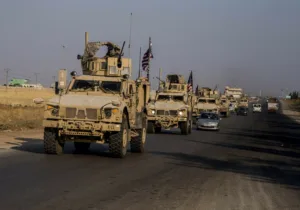Like many, my reaction to the killing of Iran’s Quds Force commander Qasem Soleimani has been an admixture of satisfaction and apprehension. It’s not equal proportions, however. If it were a cocktail, I’d be drinking two fingers worth of satisfaction and just a single pour of apprehension.
Regarding the double-dose of satisfaction, it won’t be a surprise that one of those fingers is my long one, waving bye-bye to a bad dude. As President Donald Trump said of Soleimani’s death, it’s right to “take comfort in knowing that his reign of terror is over.” Nor should it be forgotten that the airstrike also killed Abu Mahdi al-Mohandes, who, among much else, founded the Kataib Hezbollah, the Shi’ite militia linked to Iran and responsible for the rocket attack that killed American contractor Nawres Waleed Hamid and injured four other US citizens. Al-Mohandes was a key Iranian asset in Iraq and a source of much instability, brutality against minority groups, and other general mayhem. The US hit was a twofer.
The source of my apprehension is just as obvious. However great our military supremacy is over theirs, no one ought to want to get drawn into a large-scale war with Iran, and it’s no fun wondering how the Iranians are going to respond to the massive loss of Soleimani. Of course, some of the apprehension also comes from wondering what President Trump will do and whether he has a rational plan, if he is receiving and listening to wise counsel, and whether he is aiming at just ends. Many observers doubt it.
Now, one of the problems of writing to a news cycle is that, well, it can cycle anew as you write. As it happens, just as I was putting the finishing touches to this post, it was announced that Iran fired as many as 15 ballistic missiles into Iraq, with most of them hitting a pair of bases used by US forces. It was a modest bit of a “stop the presses!” moment as I waited to see how President Trump would respond.
That response now having come, my post has undergone some reconstructive surgery. What was originally going to be speculative and predictive is hereby revised to offer instead a short array of post hoc thoughts—not so much an After Action Report as After Action Reflections.
Point number one, a bit about power deployment in the Middle East: Some set up is required. Providence contributing editor Paul Miller makes what I think is one of the more nuanced versions of the commonplace charge that President Trump, in the absence of a comprehensive strategy in dealing with Iran, is resigned to simply play a never-ending game of whack-a-mole. More significant than being merely stupid, Miller charges that the whack-a-mole plan is unjust. Absent any evidence that Trump is pursuing anything other than an escalating spiral of tit-for-tat violence, his actions, Miller insists, fly in the face of the just war requirement that conflict ought to aim at peace.
Fanning some internecine passions, Providence co-editor Robert Nicholson responded to Miller with a provocative proposal offering a via media between all-out war and withdrawal. This middle way begins with the cultural observation that within the Middle East—where testosterone grows in the groundwater—groups tend to engage in “tit-for-tat skirmishes rather than large conventional wars” and cycles of violence are “just the way things work.” Accepting this, he argues, we ought to stop trying to break that cycle and, instead, master it. This partially means not getting sucked into large scale invasions in places where the conditions for a durable peace do not—and for some time likely will not—exist. Nicholson emphasizes that some will find this difficult. He writes elsewhere :
The concept of limited intervention is hard for Americans to grasp because we have trouble talking about limited anything. If we’re going to fight, we want to win. And we don’t want a technical knockout. We want the other guy splayed out on the floor.
Better, he argues, is “to obey the logic of limits: strike a balance, define boundaries, and enjoy the silence that stalemate brings.”
Curiously, given how things appear to be working out (pace the belief that Trump is clueless), the president’s actions suggest accord with Nicholson’s understanding of how power works in the Middle East. Trump has, thus far, avoided getting baited into a larger fight. Iran’s increasing misbehavior in the Persian Gulf—including the seizure of foreign vessels and crews, attack on our drone, and hit on Saudi oil facilities—was met with extraordinary restraint. In response, like someone gingerly trying to figure out where the minefield is, the Iranians continued to ratchet up the provocations. Eventually, they hit a pressure plate. By enabling the action that killed our contractor, they crossed a line. When they then responded to our punitive airstrikes by fueling the attack on our embassy in Baghdad and engaging in further plots to spill American blood, Trump took the gloves off.
The president’s actions don’t quite align with a tit-for-tat. And it’s where I think some of the confusion about Trump’s threats of a “disproportionate” response comes from. Anyone looking for tit-for-tat proportionality—including the Iranians—might have expected Trump to whack some Iranian proxies or bust up some of their partner militias. He refused to play that game, upped the ante, and struck instead at the source—making the Iranians pay with exorbitant interest. In doing so, he made clear how far the Iranians could push and gave them some sense of the cost of overreaching. As Rebeccah Heinrichs writes, proportionality in a just war sense does not mean we use only the kind and degree of force as our adversary. It means we deploy punitive power in justified scale to the offense and commensurate with just goals.
Point number two: If Trump truly did not want war with Iran, then he was clearly betting that, while taking out Soleimani would surely anger the Iranians, the expression of that rage would be limited. Apoplectic does not mean apocalyptic. The Iranian regime is a rational actor, and it wants to live. Taken together, Tehran knows that US military strength can out-escalate its own capacity for violence, and it modulated its response accordingly. Moreover, Trump has continually signaled that he considers the present account closed. With the immediate threat that Soleimani presented eliminated, Trump has given Iran every indication that he will not strike again unless they pose harm to Americans. On top of that, he has continually let them know that even the crippling sanctions can end if they come back to the negotiating table. This strongly suggests to me that peace is very much a part of Trump’s aim after all.
Point number three, a qualifier: I’m on record in support of Miller’s view that because peace is the end goal of a just war one must fight those wars so as to win them. But peace, of course, is not always going to look like the peace that might follow a conventional war. Daniel Strand is right—our adversaries have a vote as to what kind of world we will live in and what kind of relationship we can enjoy or endure with them. If two parties are at each other’s throats, it takes two of them to stop and live in peace. If two groups are at peace—or at least in a détente—it only takes one to be at war. The only choice left for the second party is whether to acknowledge the new reality. With Iran, as Nicholson points out, peace—real peace—might be nowhere in the near future. But the small-scale actions that Nicholson calls for do have their own justified ends—stop gassing these people, don’t throw missiles at those people, etc. Those more modest goals are not nothing. Peace is, at least, a composite of order and justice. We can slowly shape behaviors and realities on the ground so as to increase the measure of both. Given enough time and enough incremental increases, we just might find ourselves moving the needle closer to real accord. We don’t have to like each other in order to live in a more peaceable world.
Point number four: That said, while Trump’s response to the Iranian ballistic missile attack included overtures to peace, he also announced even more sanctions. Trump has said at length that he is not seeking regime change, but, as Brookings Institute’s Michael O’Hanlon worries, the list of requirements with which Iran needs to comply to make the sanctions stop is devastating and would effectively threaten the existence of the regime. So, while the list of demands is morally reasonable, they collectively stand no real chance. Anxious to give a cornered animal some space, O’Hanlon suggests a way to back off from some of the more stringent demands. Prudence must sometimes trump perfect justice. And trump Trump.
Point number five, a penultimate comment: With Trump, I realize that many are skeptical of trying to find a working theory behind his actions. But one can discern a rational thread in how Trump has been dealing with Iran of late. Victor Davis Hanson suggests there is even a consistency to Trump’s behavior that belies his reputation as operating only from the gut. Following the hit on Soleimani, he writes that Trump, despite campaign rhetoric and popular belief, is no old school isolationist:
“Don’t tread on me” translated into 2020 terms means something like “live and let live — or else.” If Iran hits the U.S. first, then the U.S. would shrug and hit Iran back harder — without any grand notions of preemption, ideological nation-building, regime-change agendas, ground wars, or larger policing commitments to international or allied interests.
Hanson’s speculation, to my mind, bears out. Trump’s strike on Soleimani is something quite a bit more than an alpha male dry mount to establish dominance over a rival. Even as it might have served to help Tehran know its place in the order of things, it followed a rational course. If nothing else, Tehran miscalculated. They will, at least, now miscalculate less. The Iranian Foreign Minister Javad Zarif’s tweet that they had taken “and concluded proportionate measures in self-defense” suggests that Trump’s gamble might not have been so reckless after all. But, of course, his is not the only voice coming out of Tehran. Indeed, the supreme leader, Ayatollah Ali Khamenei has already stated that the missile barrage was insufficient. And we’ve seen that memories are long in the Middle East. We would be foolish to think that Tehran is well and truly cowed.
A final point: Take everything I just said with a grain of salt. This is the Middle East. And this is Trump. So, let us simply wait and see.







 Live in the DC area? Sign-up for Providence's in-person events list!
Live in the DC area? Sign-up for Providence's in-person events list!